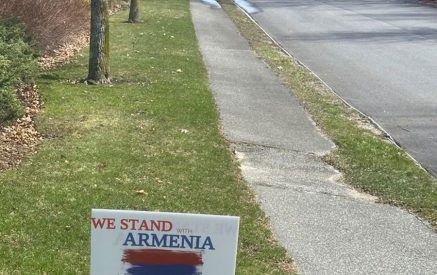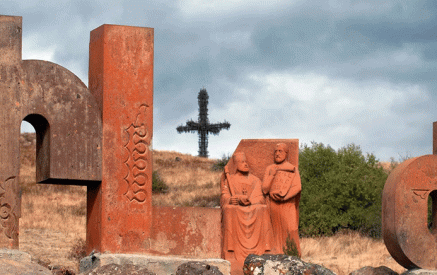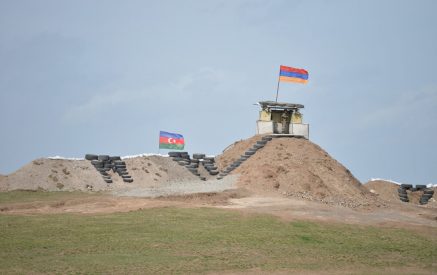The Armenian Weekly. What good is a language if it’s too sacred to use?
This year, on the occasion of the Feast of the Holy Translators, Torontohye republished ARS Armenian Private School principal Raffi Sarkissian’s 2015 article, “Armenian Must Become a Practical Language” («Հայերէնը պէտք է գործնական լեզու դառնայ», first published in Torontohye on October 29, 2015, in Western Armenian). In his piece, Sarkissian emphasizes the importance of making Armenian a practical, usable language — one that people can live with rather than admire from a distance like a museum artifact behind glass.
We included a vibrant and imaginative illustration titled “Armenian Alphabet,” created by talented Armenian-American cartoonist Myke Chilian, to accompany the article. The letters, depicted in lively and whimsical forms — sometimes anthropomorphic or even alien-like — visually embodied Sarkissian’s central idea: Armenian must be a living, breathing language.
Predictably, reactions came quickly. One of the first Facebook comments asked: “Who has distorted our Holy Letters like this?” It was as if we had committed a grave sin by daring to present the Armenian alphabet in a creative and innovative way rather than as solemn engravings on ancient stone tablets.
Read also
This brings us to the heart of the matter: a rigid, almost religious reverence toward the Armenian language — and in this case, the Armenian alphabet — is precisely the mindset we must challenge.
Why? Because when we sanctify something to the point of untouchability, we strip it of its utility and vitality. In trying to preserve its “purity,” we suffocate its growth.
Imagine if every brushstroke had to replicate the precision of European Renaissance masters or if every note had to echo Bach rigidly. Creativity would stagnate, leaving us with static forms admired from a distance but never actively engaged with. This is the danger of elevating anything — including language — to the level of untouchability.
Languages, like art and music, must evolve. They must be used — sometimes imperfectly, sometimes playfully. They must be stretched, twisted and even distorted. We need to create, sing and curse with them. Otherwise, they risk becoming irrelevant.
The difference is between a museum and a playground. A museum invites admiration but enforces distance: “Look, but don’t touch.” A playground, by contrast, invites interaction, experimentation and creativity. For Armenian to remain relevant to future generations in the diaspora, it must be more like a playground and less like a museum.
Let’s talk about our Armenian letters. Yes, they are considered sacred in their history and deeply tied to our identity. But does adding color or creativity diminish their importance? On the contrary — it breathes life into them, helping the next generation see them as something they own, not just something they are obligated to revere.
Consider English: we don’t sanctify the ABCs. We teach children with colorful, oversized letters and encourage them to play, experiment and make mistakes. We all know English is imperfect — filled with spelling inconsistencies, grammatical quirks and informal usages that have evolved over time. Yet, this very flexibility is what keeps it thriving. Who among us can claim to speak flawless English? And still, that doesn’t stop us from using it daily, mistakes and all. So why not embrace the same approach with our mother tongue? Why not treat Armenian the same way?
With Armenian, we often act as if it’s too fragile. We become gatekeepers, standing at the language’s entrance saying, “Not like this, not this way,” as if there’s only one correct way to use it. In doing so, we deter engagement and hinder the language’s natural evolution.
Those who created the Armenian alphabet — Saint Mesrop Mashtots, Saint Sahak Partev and the Holy Translators — deserve our respect, even sanctification. Their contributions gave us a writing system that has connected our people for over 1,600 years. But the letters themselves? I believe they were never meant to be objects of worship but rather tools.
And tools, by definition, are meant to be used.
The Armenian language is not an ancient relic but is living and breathing. And like all living things, it needs space to grow, adapt and even make mistakes. Honoring its legacy means using it boldly, creatively and joyfully — not locking it away in a glass box.
Let’s stop fearing “contamination” of our language. Instead, let’s immerse it in life. Let children scribble with it, let young people mix it with foreign words while striving to learn the Armenian equivalent and let artists paint it in unexpected colors. This so-called “contamination” is precisely what keeps the language alive.
For centuries, Armenian has endured empires, wars and even genocides — not because it was locked away, but because it was used in daily life. Let’s continue that tradition, this time with more courage and creativity. Our language is resilient enough to withstand our love, imagination and even our mistakes. In fact, it thrives because of them.
So, the next time you see Armenian letters presented in a fun, colorful or even unconventional way, don’t get angry. Smile. At that moment, you are witnessing the rebirth of our ancient language in the hands of a new generation.
And what could be more sacred than that rebirth?
This article was originally published in Western Armenian in the November 2024 issue of Torontohye monthly under the title ‘«Այլանդակ տառեր». սրբապղծութի՞ւն, թէ սրբազան վերածնունդ’ (“Distorted Letters: Sacrilege or Sacred Revival”). The English translation was provided by Torontohye.




























































